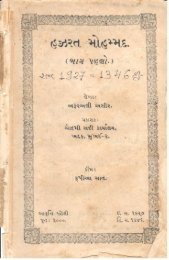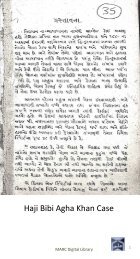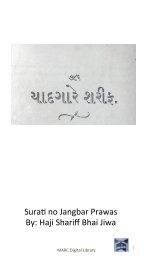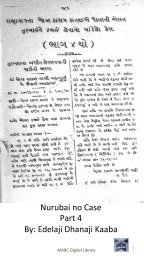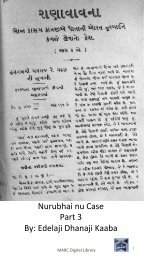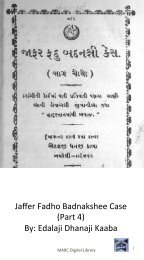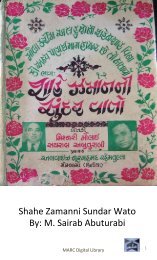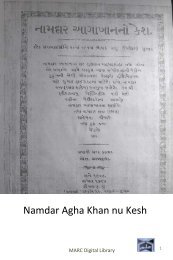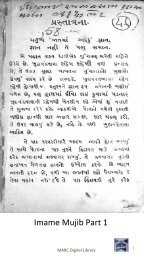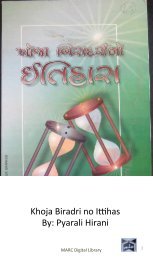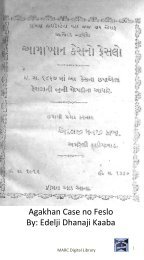WF 40 Years
My reflection
My reflection
Create successful ePaper yourself
Turn your PDF publications into a flip-book with our unique Google optimized e-Paper software.
<strong>40</strong> <strong>Years</strong> on ………. 15 October, 1976 to 15 October, 2016<br />
A Personal Reflection of an Inspiring Journey<br />
Part 1: The Genesis of <strong>WF</strong> – That’s how it was then.<br />
By: Hasnain Walji (Former Secretary General, Vice President and President 1978 – 2003 )<br />
The official date of the establishment of the World Federation is October 15 1976. However,<br />
the genesis is almost a year prior when in October 1975, when a delegation from Africa sat<br />
down with some elders form Uganda and a group of young Khoja accountants and lawyers on<br />
the red carpet of the Hammersmith Imambargah in London.<br />
As the assistant Secretary of London Jamaat, along with the then Mukhi Saheb Anverbhai Jagani<br />
and Anverbhai Pirbhai, our duty, on that dull and damp October day, was to ensure that the<br />
delegation were suitably nourished, Khoja style, with steaming hot chai and samosas. As we<br />
poured them endless cups of tea, amidst the smoke from Rothmans Cigcrettes, I overheard this<br />
motely group ponderously reflecting on the predicaments our Community had found itself in<br />
the wake of the 1972 Uganda Exodus. Over a thousand souls had now scattered across the<br />
globe trying to make a new life in these faraway places. Apart for London and Peterborough,<br />
most communities in UK and North America were yet to establish Jamaats Imambaagahs. Yet<br />
the Community spirit was strong as mumineen as roiled out carpets from the trunks of their<br />
cars to sit in rented warehouses, basements or any place that would give them an opportunity<br />
and be spiritually uplifted through the recital of Dua e Kumail on Thursday nights. For Living in<br />
city or town without a Jamaat, a Khoja individual was like a fish out of water and these small<br />
gatherings became the oasis of spirituality in the new land we found ourselves.<br />
As I caught snippets of their conversations, an example that has stuck in my mind almost <strong>40</strong><br />
years on, was how the Mulla Asgher, then based in Kenya, had to coach volunteers over a<br />
crackly landline (No Skype in those days) phone in USA as they attempted gave Ghusle mayyit<br />
to a Community member who had the misfortune to die in that remote corner of the world.<br />
Little did I realize then, that history was being repeated. It was just hundred or so years ago<br />
when the first lonely migrants had arrived in Lamu and Zanzibar and grappled with similar<br />
challenges of making a new life in foreign lands. This time round, the Khojas were once again<br />
struggling to settle in Europe and Americas. The challenges were similar as were some<br />
occupations. In the UK, the East African ‘dukawalla’ had a new name: “tobacconist”, but the<br />
game was the same.
The decades old London Based “Ithnaasheri Young Men’s Union” which used to hold Majalis at<br />
the East Africa House (Cumberland Placce in Marble Arch), had morphed into what we now<br />
know as London Jamaat. At the Hammersmith Imambargah, bought with meagre resources,<br />
laboriously garnered by elders, championed with extraordinary zeal by the Late Haji Habibbhai<br />
Walji, creative tension soon manifested itself between the newly qualified London based young<br />
professionals as they engaged with the older and experienced leadership of Uganda Jamaats<br />
who longed to recreate the Uganda Experience. But all of us agreed that the sweetest part of it<br />
all was the rich condensed milk pink sherbet on Ashura Day after the spicy Khichdo, (Daal<br />
Chawal on Ashura came later) as the young and the not so young Jamaat members learnt to<br />
accommodate each other. We would still have continued the Khichdo if we knew the<br />
egalitarian history of khichdo! t may surprise you to note, that Its origins come from the<br />
practice of Jamaats in Kutch and Kathiawad, (in the pre Khoja Pilwa era) where Khichdo was a<br />
communal meal cooked in the Khoja Dheg. The rich brought the meat and the poor brought the<br />
grain. This way everyone felt that they had contributed to Niyaz. It is a vagary of history that the<br />
khichdo was elevated to a celebratory meal. But then I could write a tome on the vagaries of<br />
Khoja History!<br />
The leaders form Africa, Late Mulla Asgher, Late Abdul Rasul Lakha. Murabbi Hassan Bhai Jaffer<br />
amongst others impressed upon the UK based leaders in attendance like Late Hasni Bhai<br />
Dharamsi, Habb M Habib, Late Husein Nathoo and Nazir Jessa, amongst others, to help<br />
replicate the structure of Africa Federation formed in 1946, to form a World body to address<br />
the needs and growth of Khoja Shia communities in the USA, Canada, UK, UAE, Far East and<br />
elsewhere. The action point that resulted was to form a small team to begin to write a<br />
Constitution and then call a constitutional Conference within a year. Soon the London based<br />
team of led by Habib M Habib in consultation with some leaders in Africa got to work. Of<br />
course, armchair critics got to work too. They gingerly opined that Mulla Asgher, the then<br />
Chairman of the Africa Federation wanted a bigger ‘Chair’ for himself.<br />
Fast Forward to a year later October 15 1976 - exactly <strong>40</strong> years ago today - the group met again<br />
at the Hammersmith Imambargah. Except this time, they were joined by delegates from Africa<br />
Federation and the newly formed Jamaats of Peterborough, Birmingham, Leicester, Toronto<br />
Los Angeles and New York. The Vision was lofty. Boldly the 60 dedicated delegates took upon<br />
themselves help and serve this nascent organisation to attend to the community’s financial,<br />
spiritual and educational needs globally.<br />
‘Let me begin at the beginning. The concept of the World Federation dawned upon us by the<br />
events in Uganda.’ So began Marhum Mulla Asgherali M.M. Jaffer’s inaugural address at the<br />
First Constitutional Conference. Interestingly, of the three-day Constitutional Conference,<br />
almost a day was spent on a noteworthy debate. “To call ourselves Khoja or not - that was the<br />
question” Hours of passionate discussions took place on the merits of identity, closed<br />
membership and the scope of service.
The seasoned African delegation, joined by the down-to-earth UK delegates leaned towards<br />
keeping it within the Khoja, while the enlightened North American delegation wanted to open it<br />
to the entire Shia world. In the end, the <strong>WF</strong> Founding Fathers (No females were in sight in those<br />
days!) came up with a characteristically pragmatic solution. The word Khoja would be retained<br />
in the title, to credit the Khojas for initiating it but the membership and services would be open<br />
to all.<br />
The meeting acknowledged that emergence of a Khoja diaspora upon the eviction of Asians<br />
from their Ugandan homes under Idi Amin, the Africa Federation was inundated with requests<br />
from Khojas globally - for Islamic literature, alims, marital advice, educational and other<br />
services. This would now be attended to by the newly formed World Federation. The spirit at<br />
the conference was optimistic and at the same time awe inspiring. Manzoor Kanani as part the<br />
delegation from Africa, who went on to serve as Vice President decades later recalls “ As I sat in<br />
the Conference on that Saturday October 16 1976, I wondered how were we going to do this?<br />
Where would the money come from? Did we really have the capacity to undertake such a<br />
mammoth task?”<br />
Muhsin Dharamsi. then a youthful civil engineer full of vigour, (which remains unabated even<br />
today) envisioned the framework of the organization that he as Secretary General a few years<br />
later, enshrined in the administrative machinery which served us in good stead for years and<br />
established a strong foundation upon which the edifice stands today. His meticulous insistence<br />
on the conduct and documentation of conference was legend as was his color coded filing<br />
system. Over the many years, his penchant for files was such that any free wall at the humble<br />
secretariat at Stanmore would be embellished with shelves and soon one would see files upon<br />
files on it. The running joke at the secretariat was: don’t stand still otherwise Muhsin will build<br />
a shelf in your back thinking it is another wall. But the current humble secretariat office is<br />
grand compared to the first office at Meralis’ in Rayners Lane. Starting from a few box files<br />
housed at the residence of the First Secretary General Anwarbhai Jagani, it progressed to the<br />
bottom drawer of the filing cabinet in the small back room of my Travel Agency on London’s<br />
Holloway Road and subsequently thanks to the generosity of Mahmud P K Merali, offering a<br />
whole room at the subsidised rent of 25 pounds a week , which he sometimes forgave as the<br />
Secretariat could not afford to pay.<br />
As the saying goes – nature abhors vacuum. No sooner it was established, expectations rose<br />
and requests began coming from areas as far off as Vancouver, the Bahamas and Bangkok.<br />
Once established, the World Federation faced two immediate if ambitious tasks. One was to<br />
raise the balance of funds from zero. Along with Khums monies, donations were the primary<br />
source of revenue in the first term, with less than £100,000 received by end of 1979.
Secondly, the Office Bearers realized the need assess each particular situation and to that end<br />
the Late Maulana Syed Amir Husain Naqvi was assigned to tour the Jamaats in America,<br />
Europe, Canada and the Far East and produce a detailed report of each area. Thereafter, with<br />
limited funds, the unenviable job of prioritising requests began.<br />
Strategically, (without even using the word), the <strong>WF</strong>’s first two terms (1976-79, 1979-1982)<br />
were dedicated to alleviating the abject poverty of the East and the paucity of religious services<br />
and Centers in the West. Removing disease, poverty and illiteracy within India was the pressing<br />
priority. The Khojas of Africa who had hardly ever looked back to where they came from, found<br />
two champions whose personal friendship and the passion to serve the Community, bridged<br />
the chasm across the Indian Ocean. They were none other than Mulla Asgher and Late<br />
Gulamali Bhanji (Bapu). Alhajj aunalibhai Saleh Mohammed, a rare soul who had migrated from<br />
Dar es Salaam to Surat, became the third in this triumvirate to serve the Khojas of India.<br />
In conjunction with the Masoomeen Trust of Bombay headed by Gulamali Bhanji, housing<br />
complexes, madrassahs, masjids, imambarghas and medical treatment camps were funded and<br />
run. After attempts to create an All-India Federation floundered, the Gujarat Federation was set<br />
up in 1979 with the unified objective to uplift the Shias of Kutch and Kathiawad. Initial<br />
temporary relief in the form of handouts soon made way for capital schemes of investment in<br />
housing, education, agriculture and job creation. To alleviate poverty, the first ‘Samuh Lagna’<br />
was organized in 1978., with painstaking efforts by the then Vice President, Late Haiderbhai<br />
Haji. Weddings in a culture steeped in Indian tradition remain crippling burden on poor families<br />
and at hence, at times prevented marriage altogether. The <strong>WF</strong> and Gujarat Federation<br />
organised ‘Samuh Lagna’ – an event to host multiple weddings at a go at little cost to the<br />
wedding parties, arranging as many as 80 weddings at a time during its early years.<br />
Soon, inspired by our Canadian brethren, and in particular Late Gulamabbas Sajan, the<br />
Zainabiyya Child Sponsorship Scheme was inaugurated in 1981, to sponsor the poor to<br />
educate themselves out of dependence. The ZCSS scheme began humbly, sponsoring 9 children<br />
at the cost of 50 cents per child/day in 1981. Muhsin Dharamsi, who in his inimitable style has<br />
created detailed paperwork for the scheme, at the Rayners Lane secretariat was taken aback<br />
when Mulla Saheb, wagging £500 notes challenged us all “Here – Take this and lets start NOW,<br />
and stop just talking about it.”<br />
In spite of limited resources , but with dogged persistence the <strong>WF</strong> helped fund many<br />
imambargha projects in the West. Even more pronounced was the need to disseminate Islamic<br />
education to the youth in the West. Indeed the very first committee of the <strong>WF</strong> was the Islamic<br />
Education Subcommittee, which then became a fully-fledged Islamic Education Board in 1980.<br />
Its brief was to enhance Islamic learning in the west through the provision of Islamic literature,<br />
correspondence courses, training of alims and teachers, reviewing of teaching techniques in<br />
madrassahs and utilising of audio-visual aids.
Today, <strong>40</strong> years on, history testifies, that indeed successive leaderships and at least three<br />
generations of volunteers continue to be true to the mantra “We exist to Serve”. The World<br />
Federation’s accomplishments are a acknowledgement of the vision of the Founders some <strong>40</strong><br />
years ago. The trajectory has had its successes and challenges as we shall review in the<br />
forthcoming instalments of this <strong>40</strong> year journey – That’s how it was then !<br />
To be continued …….. Inshallah<br />
Houston – Oct 15 2016





